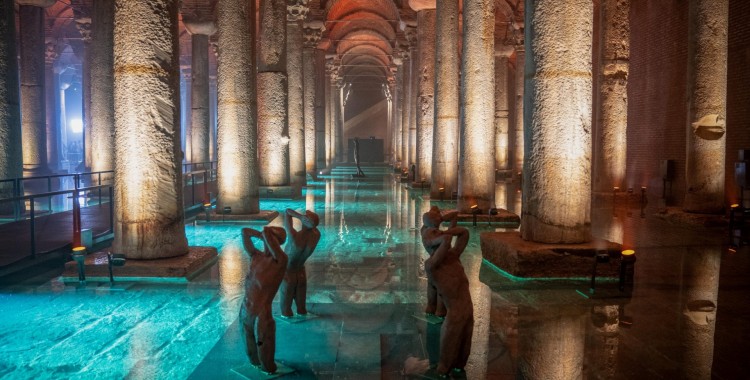Istanbul Basilica Cistern

Istanbul Basilica Cistern
Basilica Cistern, bearing the traces of Istanbul's ancient history, was built by Emperor Justinian in the 6th century. The historical cistern, which was like a calm ocean in its time with its water capacity of 80 thousand tons, is called "Cisterna Basilica" in Latin.
The building, which is also known as the Basilica Cistern today, met the water needs of the city for centuries by distributing the water obtained from waterways and rain to the Great Palace and surrounding structures where the emperors resided. Basilica-planned Basilica Cistern, which is the largest closed cistern in the city and stands out for having more spolia supporting elements than other closed cisterns; It contains a total of 336 columns in 28 columns oriented east-west and 12 columns oriented south-north. It is estimated that most of these columns in the cistern, which can be accessed via a 52-step stone staircase, were collected from older buildings.
Covering an area of approximately 1000 square meters, the cistern is 140 meters long and 65 meters wide; After the conquest of Istanbul by the Ottomans in 1453, it was used for a while for the needs of Topkapı Palace.
It is also known that the historical cistern was used as a water well by the public with the gradual onset of residential development in the region. The structure, which was not noticed by Westerners until the mid-16th century, was virtually rediscovered by Petrus Gyllius, a naturalist and topography expert who lived in Istanbul between 1544 and 1555.
During the Ottoman period, III. It was built for the first time by the architect Kayserili Mehmed Ağa during the reign of Ahmed II. The Basilica Cistern, which was repaired for the second time during the reign of Abdulhamid, continued to undergo repairs in the following years. In 1955-1960, 9 columns at risk of breaking were covered with a thick layer of concrete.
Medusa heads, the most important symbol of the Basilica, were discovered during the comprehensive repair and cleaning works carried out by the Istanbul Metropolitan Municipality between 1985 and 1987. Among the Medusa heads used as column bases, the one located in the west of the building is upside down, while the one in the east is horizontal. The Medusa heads here are thought to have been brought from Çemberlitaş, as they have similar features to the Medusa head samples found in the garden of the Istanbul Archaeological Museums and near the Tiled Kiosk.
The magnificent building, which was opened to visitors as a museum by Istanbul Metropolitan Municipality in 1987 after restoration, hosted various national and international events over time. The multi-layered memory of the Basilica Cistern, which extends back to 1500 years and preserves its value as a common heritage of humanity, continues to be a source of inspiration for the future.
You can visit the Basilica Cistern on our Daily Istanbul Tours.
Reservations: info@istanbulshuttle.com
WhatsApp: +90 530 580 2807